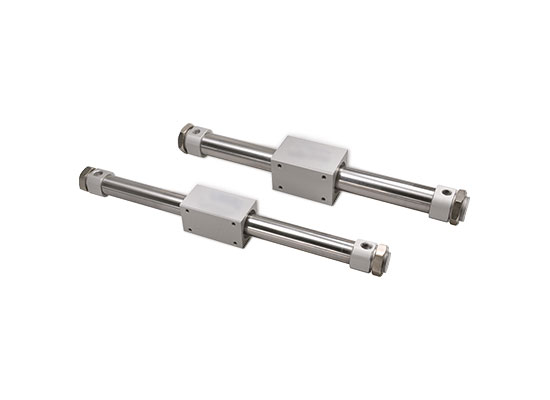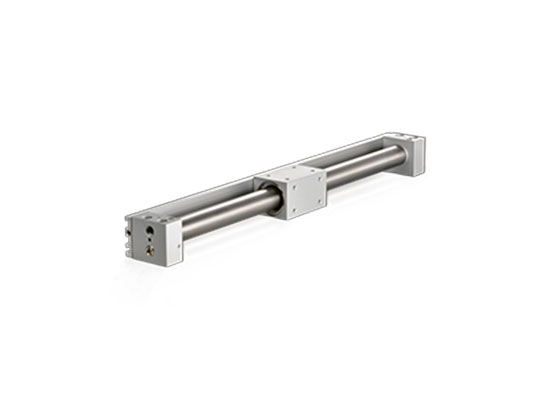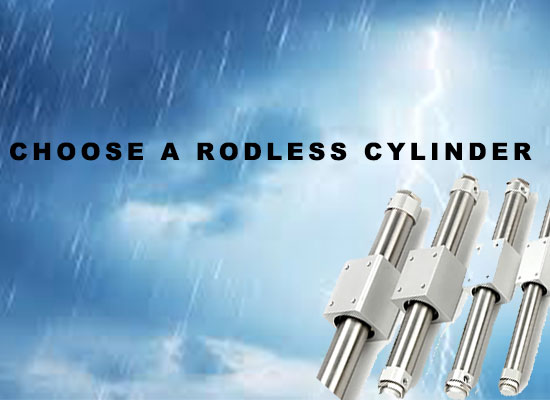Feb 05, 2025
Rodless cylinders, also known as linear actuators, are innovative pneumatic components that enable linear motion without the need for a piston rod.
This unique design allows for longer strokes compared to traditional cylinders with rods, making them ideal for space-constrained applications or scenarios requiring extensive travel distances.
The motion is achieved through mechanisms like magnetic coupling or internal bands, ensuring precise and reliable operation.
Thanks to their compact structure and flexibility, rodless cylinders are widely used in automation systems, material handling, and industrial machinery.
They are known for their space efficiency, ease of installation, and ability to handle heavy loads over extended distances, making them a versatile choice for modern engineering solutions.

Rodless cylinders are a type of pneumatic cylinder powered by compressed air, commonly used in applications such as conveyor systems, drive mechanisms, and customized handling equipment.
There are two common variants of the rodless cylinder.In mechanically coupled designs, motion is transmitted through a lateral linkage connected to the piston, requiring a slit in the cylinder's profile for operation.
Magnetically coupled variants, on the other hand, rely on magnetic forces to transfer motion through a sealed profile, eliminating the need for openings.
Both designs offer a compact solution, requiring significantly less installation space compared to traditional piston rod cylinders.
They allow for significantly extended motion ranges compared to traditional piston rod cylinders.
Their shorter overall length makes them ideal for tight spaces.
Equipped with mounting grooves on various sides, they support the direct integration of modular components like brakes and sensors.
The use of inner and outer sealing bands ensures reliable sealing performance, even for long strokes.
Their compact size and modular capabilities make them highly adaptable to diverse applications.
The working principle of rodless cylinders involves using compressed air to drive an internal piston along the length of the cylinder and transferring this motion to an external carriage, enabling precise linear movement of a load.
Here’s a detailed breakdown:
The cylinder has two separate air chambers. By controlling the compressed air supplied to each chamber, a pressure differential is created that drives the piston to move within the cylinder.
When one chamber is pressurized, the piston moves toward the opposite side, and vice versa.
Mechanically Coupled Cylinders:
A rigid mechanical link, such as a rod or band, connects the piston inside the cylinder to an external carriage.
This connection passes through a narrow slit in the cylinder wall, which is sealed by inner and outer sealing bands to maintain airtightness while allowing the carriage to move freely.
A strong magnet inside the piston interacts with a corresponding magnet in the external carriage.
The motion is transmitted through the sealed cylinder wall via magnetic force, eliminating the need for physical openings and ensuring complete enclosure.
By alternating compressed air between the two chambers, the piston can move in both directions.
This bidirectional movement is transferred to the external carriage, enabling precise and smooth linear displacement.
The external carriage, attached to the piston, transfers the motion to the load.
It often includes guide systems to ensure stable, accurate movement, especially under heavy loads or long strokes.
Magnetic rodless cylinders use a magnetic connection between the piston and the carrier. The magnetic coupling ensures a leak-free design, as there are no physical openings in the cylinder.
However, the cylinder body can be more fragile, and there is a potential risk of decoupling of the carrier over time if the magnetic force weakens.
These cylinders are often used in environments where air-tightness and clean operation are critical.

Cable-driven cylinders employ a cable that connects the piston to the carrier, passing through pulleys at either end.
This design is simple and cost-effective, but the cable can wear over time, affecting the cylinder's performance.
Cable stretching can lead to inconsistent positioning and may cause air leaks, reducing efficiency and reliability in the long run.
Slotted rodless cylinders are equipped with a slot running along the length of the cylinder. They feature inner and outer metal bands that ensure an airtight seal.
This design offers a direct mechanical connection between the piston and the carrier, making it the most versatile and widely used type of rodless cylinder.
The slotted design provides a robust and reliable solution for applications requiring long strokes, high loads, and precision.
The driving force of a rodless cylinder is typically transmitted directly to the load through the sliding components inside the cylinder, rather than through an external piston rod.
Therefore, when selecting and using a rodless cylinder, the following factors need to be considered carefully:
Static Load: Weight that remains constant during operation, such as fixed objects or steady material transport.
Dynamic Load: Loads that change during operation due to acceleration, deceleration, or external forces (e.g., vibration).
Ensure the cylinder's load capacity matches or exceeds the expected weight.
Consider the distribution of the load—uneven or off-center loads can cause misalignment, increased wear, or instability during operation.
Rodless cylinders handle not just vertical forces but also moments (torques) caused by:
Pitch Moment: Rotation around the horizontal axis due to uneven load distribution along the cylinder’s length.
Yaw Moment: Lateral rotation around the vertical axis from off-center forces.
Roll Moment: Rotation along the cylinder’s travel axis due to uneven load application or twisting forces.
Guides or additional supports may be required to counteract these moments and maintain smooth operation.
Proper alignment between the load and the cylinder is critical to avoid excessive wear and stress on the carriage. Misaligned loads can reduce the cylinder's lifespan and compromise precision.
High-speed or rapid acceleration/deceleration can generate additional dynamic forces, requiring the cylinder to handle loads beyond the static weight.
Cushioning or braking mechanisms may be needed for smooth operation.
Ensure the cylinder's mounting orientation (horizontal, vertical, or inclined) is compatible with the load's weight and forces.
Vertical mounting requires the cylinder to counteract gravitational forces, increasing the load demands.
External conditions like vibration, temperature, or contamination (dust, moisture) can impact load handling.
For harsh environments, magnetic or slotted cylinders with protective seals may be more suitable.
Provide stable support and prevent rotation or shifting.
Offer additional support for long-stroke cylinders and distribute loads evenly.
Detect the position of the carriage or load to control motion and prevent overtravel.
Support and guide the load, ensuring stability and minimizing wobble during motion.
You May Interest In

Jan 13, 2025 Blog
Choosing a Rodless CylinderFOKCA ©1998-2025 Fescolo Pneumatic All Rights Reserved Sitemap